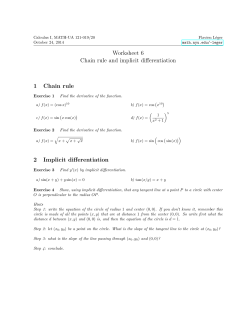
Embry-Riddle Aeronautical University Jacobs MA 243 Final Examination (Sample)
Embry-Riddle Aeronautical University Jacobs MA 243 Calculus III Final Examination (Sample) Problems 1 - 12 are multiple choice questions worth 4 points apiece. Show all work on the rest of the problems. 1. Let T be the triangle in the xy ∫∫ plane with vertices (0, 0), (1, 1) and (−1, 1). Which of the following double integrals will equal T (x + y) dx dy if we make the following transformation: x=u−v y =u+v a) c) ∫ 1∫ 1 4 dv du 0 0 ∫ 1∫ 1−u 0 0 b) 2u dv du d) ∫ 1∫ 1−u 4u dv du 0 0 ∫ 1∫ u 0 −u 2u dv du 2. Which of the following is the vector equation of the line that passes through the points (1, 1, 1) and (1, 0, 2)? a) ⟨x, y, z⟩ = ⟨1, 1, 1⟩ + t⟨1, 0, 2⟩ b) ⟨x, y, z⟩ = ⟨1, 1, 1⟩ + t⟨0, −1, 1⟩ c) ⟨x, y, z⟩ = t⟨0, −1, 1⟩ d) ⟨x, y, z⟩ = ⟨1, 0, 2⟩ + t⟨1, 1, 1⟩ 3. Which one of the following equations represents a plane that is perpendicular to the xz-plane? a) y = z b) x = 1 − y c) y = 1 − z d) z = 1 − x 4. Which vector is tangent to the curve ⃗r(t) = ⟨t, cos t, sin t⟩ at t = a) ⟨ π2 , 0, 1⟩ b) ⟨1, −1, 0⟩ 5. If z = x2 e3y + x3 + y find a) 2xe3y c) ⟨0, −1, 0⟩ π 2 ? d) ⟨1, 0, 0⟩ 2 ∂ z ∂x∂y b) 6xe3y c) 2e3y d) 2xe3y + 3x2 + 1 ∫ ∞∫ y 6. Which of the following double integrals equals 0 0 f (x, y) dx dy ? ∫ y∫ ∞ ∫ ∞∫ x a) 0 0 f (x, y) dy dx b) 0 0 f (x, y) dy dx ∫ x∫ ∞ ∫ ∞∫ ∞ c) 0 y f (x, y) dy dx d) 0 x f (x, y) dy dx 7. If f (x, y) = x sin y, which of the following is ∇f ? a) sin y + x cos y b) x cos y + sin y c) ⟨sin y, x cos y⟩ d) ⟨x cos y, sin y⟩ ( π π) 8. If (ρ, θ, ϕ) = 4, 4 , 6 are the spherical coordinates of a point and (r, θ, z) is the same point in cylindrical coordinates, calculate r √ √ a) 2 b) 2 2 c) 2 3 d) 4 ∫ 2∫ 9. Calculate the double integral: 0 a) 1 6 b) 1 3 c) 4 3 1 2 ( )2 x dy dx y d) 3 10. Let f (x, y) = x2 + 4y 2 . If (x, y) changes from (1, 1) to (1.5, 1.25), which of the following is the value of the differential df ? a) 2 b) 2.5 c) 3 d) 3.5 11. Let T be the region below z = 12 − 4x − 2y for x ≥ 0, y ≥ 0 and z ≥ 0. Which of the following triple integrals represents the volume of T ? ∫ 6∫ 6−x∫ 12−4x−2y a) ∫ 3∫ 1 dz dy dx 0 0 0 ∫ 6∫ 3∫ 0 0 0 ∫ 6∫ 3∫ 1 dz dy dx 0 1 dz dy dx 0 12−4x−2y c) 6−2x∫ 12−4x−2y b) 0 12 d) 1 dz dy dx 0 0 0 12. Which of the following shows the level sets of f (x, y) = e−(x 2 a) b) c) +y 2 ) ? d) 13. (8 points) Let T be the region above the paraboloid z = 1 − x2 − y 2 and below the paraboloid z = 3 − 3x2 − 3y 2 . Find the volume of T . Show all work. 14. (8 points) Let C be the straight line path connecting (−1, 0) to (1, 2). ⟨ ⟩ ∫ ⃗ = y(x − y)−2 , −x(x − y)−2 . Calculate the line integral ⃗ • d⃗r Let F F C 15. (8 points) Let R be the triangular region in the xy plane that is bounded by the positive x-axis, the positive y-axis and the lines y = x and y = 1. √ Find the surface area of the portion of the cylindrical surface z = 1 − y 2 that is directly above R. Show all work. 16. (8 points) Find the maximum volume possible for a box sitting on the xy plane inscribed under the paraboloid z = 4 − x2 − y 2 17. √ (10 points) Let Ω be the region in the xy plane that is above the x-axis and below the semicircle y = 1 − x2 . Find the coordinates of the centroid. Show all work. ⃗ = ⟨r cos θ, r sin θ, 1 − r⟩ for 18. (10 points) Let Ω be the cone described by the equation R ∫∫ ⃗ = ⟨−y, x, z⟩. Calculate the surface integral ⃗ • ⃗n dS 0 ≤ r ≤ 1 and 0 ≤ θ ≤ 2π. Let F F Ω
© Copyright 2025





















